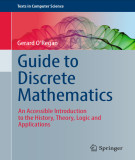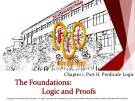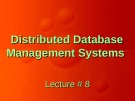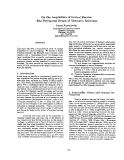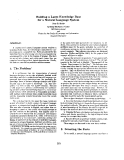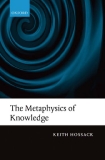
Predicate calculus
-
Part 2 of ebook "Guide to discrete mathematics: An accessible introduction to the history, theory, logic and applications" provides readers with contents including: Chapter 10 - Cryptography; Chapter 11 - Coding theory; Chapter 12 - Language theory and semantics; Chapter 13 - Computability and decidability; Chapter 14 - A short history of logic; Chapter 15 - Propositional and predicate logic; Chapter 16 - Advanced topics in logic; Chapter 17 - Software engineering mathematics; Chapter 18 - Formal methods; Chapter 19 - Z formal specification language; Chapter 20 - Probability, statistics and...
 208p
208p  daonhiennhien
daonhiennhien
 03-07-2024
03-07-2024
 3
3
 1
1
 Download
Download
-
Lecture Discrete mathematics: Chapter 1.1 helps you to explore concepts in discrete mathematics using in computer systems. By following the book "Discrete Mathematics and Its Applications," Seventh Edition, by Kenneth H. Rosen, an introduction to the mathematical structures and concepts used in computing: sets, mathematical induction, ordered sets, Boolean algebras, predicate calculus, graphs, trees and relations will be presented in the course. Please refer to the detailed lecture content!
 15p
15p  diepkhinhchau
diepkhinhchau
 18-09-2023
18-09-2023
 5
5
 3
3
 Download
Download
-
Lecture Discrete mathematics: Chapter 1.2 provide students with content about: predicate logic (first-order logic (FOL), predicate calculus); the language of quantifiers; logical equivalences; nested quantifiers; translation from predicate logic to English; translation from English to predicate logic;... Please refer to the detailed lecture content!
 57p
57p  diepkhinhchau
diepkhinhchau
 18-09-2023
18-09-2023
 3
3
 3
3
 Download
Download
-
Distributed Database Management Systems: Lecture 8. The main topics covered in this chapter include: derived relational algebra ops; relational calculus; semi join; first-order predicate logic; atomic formula;...
 36p
36p  haoasakura
haoasakura
 30-05-2022
30-05-2022
 18
18
 4
4
 Download
Download
-
Chapter 8: First-order logic. The main contents of this chapter include all of the following: First-order logic: objects and relations are semantic primitives; syntax: constants, functions, predicates, equality, quantifiers; Increased expressive power: sufficient to define wumpus world; Situation calculus: conventions for describing actions and change in FOL; situation calculus: can formulate planning as inference on a situation calculus KB.
 6p
6p  cucngoainhan0
cucngoainhan0
 10-05-2022
10-05-2022
 16
16
 2
2
 Download
Download
-
Lecture Artificial Intelligence - Chapter 8: First-order logic. The main contents of this chapter include all of the following: First-order logic: objects and relations are semantic primitives; syntax: constants, functions, predicates, equality, quantifiers; Increased expressive power: sufficient to define wumpus world; Situation calculus: conventions for describing actions and change in FOL; situation calculus: can formulate planning as inference on a situation calculus KB.
 32p
32p  cucngoainhan0
cucngoainhan0
 10-05-2022
10-05-2022
 22
22
 3
3
 Download
Download
-
In this chapter, the following content will be discussed: A “logical” anecdote, predicate calculus (first order logic), language, conditional statements, invariant condition in iteration, loop invariants, weakest pre-condition for while statement,...
 8p
8p  larachdumlanat126
larachdumlanat126
 31-12-2020
31-12-2020
 19
19
 1
1
 Download
Download
-
This paper describes a computational model of concept acquisition for natural language. W e develop a theory of lexical semantics, the Eztended Aspect Calculus, which together with a ~maxkedness theory" for thematic relations, constrains what a possible word meaning can be. This is based on the supposition that predicates from the perceptual domain axe the primitives for more abstract relations. W e then describe an implementation of this model, TULLY, which mirrors the stages of lexical acquisition for children. ...
 7p
7p  bungio_1
bungio_1
 03-05-2013
03-05-2013
 39
39
 1
1
 Download
Download
-
A sophisticated natural language system requires a large knowledge base. A methodology is described for constructing one in a principled way. Facts are selected for the knowledge base by determining what facts are linguistically presupposed by a text in the domain of interest. The facts are sorted into clnsters, and within each cluster they are organized according to their logical dependencies. Finally, the facts are encoded as predicate calculus axioms.
 4p
4p  bungio_1
bungio_1
 03-05-2013
03-05-2013
 47
47
 2
2
 Download
Download
-
Ever since Woods's "What's in a Link" paper, there has been a growing concern for formalization in the study of knowledge representation. Several arguments have been made that frame representation languages and semantic-network languages are syntactic variants of the ftrst-order predicate calculus (FOPC). The typical argument proceeds by showing how any given frame or network representation can be mapped to a logically isomorphic FOPC representation.
 9p
9p  bungio_1
bungio_1
 03-05-2013
03-05-2013
 61
61
 2
2
 Download
Download
-
A gripping title and project, much metaphysical rigour, and some underdeveloped epistemology. That is what Keith Hossack has given us. The title of his book trails a bold scent, guaranteed to entice those of us who wander within metaphysics and epistemology. Combine those areas, and excitement beckons. This book's beguiling title suggests a goal of uncovering the metaphysical microstructure of knowledge itself. Not in this case, though, emphatically not.
 328p
328p  fangfangfang
fangfangfang
 11-05-2012
11-05-2012
 72
72
 14
14
 Download
Download
CHỦ ĐỀ BẠN MUỐN TÌM








